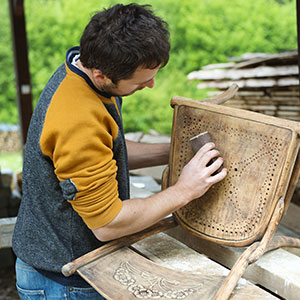DIY: Restoring wooden furniture
Step 1: Preparation
For the restoration of wooden furniture you need different tools and accessories:
- sandpaper with grain size 180 or 240
- steel wool
- a rag and a bucket of water
- a broad brush
- a paint/stain for more intense colors or a wax/oil for a natural look
- a polish or oil-wax for the finish
- a soft cloth
Step 2: Remove old paints
First, remove old paints, dirt and polish residues with the aid of sandpaper. Always work in the direction of the wood grain to prevent damage of the often delicate wooden furniture. Inaccessible areas, such as carvings, are easier to treat with steel wool. After the piece of furniture has been sanded evenly, the surface must be freed from the dust. Use a slightly moistened cloth and let the furniture dry sufficiently.
Step 3: Wooden furniture in a new light
In the third step, you can finally decorate your furniture as you desire. Differently colored lacquers, stains and oils give you the opportunity to determine the color and the later look of your furniture piece yourself. If you treat your wooden furniture with oils or stains in natural colors, you can emphasize the color of the grain and that way bring a natural flair into the living room. Furniture treated with color rich paints appear modern and may, through stylistic inconsistencies and unusual color schemes, add a touch of extravagance to your home.
TIP for allergic and sensitive people: LIVOS produces environmentally friendly and healthy products that are suitable for sensitive people, asthmatics and children. Our product range "LIVOS Neutral" has been developed especially for allergy sufferers, MCS patients and people highly sensitive to odors.
When restoring your furniture, make sure you apply the paint evenly and quickly in the direction of the wood grain. The brush should not be too heavily soaked with stain, varnish or paint, as this could cause unsightly paint chips or streaks. After the application let the furniture dry.
Step 4: Polishing and protecting
The final step when restoring your furniture is the sealing or polishing. Depending on how you have treated your furniture before, you need to choose the right product for surface protection. Polish is suitable for giving unpainted or oiled surfaces a great shine. Leached, oiled, stained or waxed furniture surfaces obtain an excellent protection against moisture and dirt with help of wood oils or natural oil sealers.Particularly stressed surfaces such as tables or shelves in the kitchen can be particularly well protected with a special worktop oil. These products can be easily applied with a soft, clean and dust-free cloth. This way, you make sure that your wooden furniture look beautiful for a long time and are easy to clean and to maintain.
Photo credit: © Halfpoint- iStock.com


